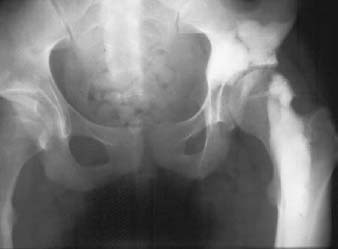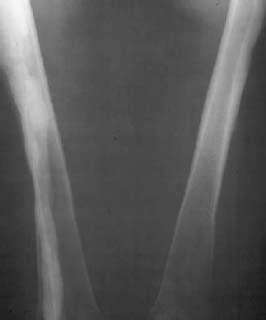CASE 32 Anthony G. Ryan and Peter L. Munk A 40-year-old female patient reported chronic discomfort and stiffness in the lower extremities, that had been present for many years and had been slowly progressive. Figure 32A Figure 32B Radiographs of the pelvis and thighs were obtained. Anteriorposterior views of the pelvis (Fig. 32A) and femora (Fig. 32B) show areas of strikingly dense ossification involving the acetabulum and femur on the left. The ossification has a strikingly “flowing” pattern especially apparent in the femur. At the lateral aspect of the femur the margin of the ossification has an undulating lobulated appearance in keeping with the classic pattern of dripping candle wax. The changes involve both the cortex and adjacent soft tissue. Melorheostosis. Other sclerosing bone dysplasias: Other sclerosing lesions: Melorheostosis is a rare nongenetic congenital mesodermal anomaly that gives rise to a sclerosing bone dysplasia, predominantly affecting the long bones of the upper and lower limbs, the short bones of the hand and foot, and, rarely, the axial skeleton. Often diagnosed incidentally in adults, the condition is characterized radiologically by progressive hyperostotic linear densities in bone in a sclerotomal distribution (zones of the skeleton supplied by individual spinal sensory nerves). Multiple sclerotomes may be involved, and if so, the clinical manifestations are correspondingly more severe. It may coexist in a so-called overlap syndrome known as mixed sclerosing bone dystrophy (MSBD) with osteopoikilosis and osteopathia striata, as well as with tumors, vascular malformations, lymphangiectasis, or fibrolipomatous lesions. Typically, the cutaneous and other clinical features occur in the same sclerotome as the affected bone(s). The etiology is unknown, although it is postulated to be a developmental error secondary to an embryonic metameric abnormality, resulting in disturbances in either enchondral or intramembranous bone formation, or both (abnormalities of the latter dominating). The sclerotomal distribution has given rise to a theory proposing that melorheostosis may be the late result of a segmental sensory nerve lesion. The developmental disturbances result in defects in bone resorption and/or formation during the processes of skeletal maturation and modeling, resulting in hyperostotic bone.
Melorheostosis
Clinical Presentation


Radiologic Findings
Diagnosis
Differential Diagnosis
Discussion
Background
Etiology
Pathophysiology
Stay updated, free articles. Join our Telegram channel

Full access? Get Clinical Tree


